Happy Evacuation Day! On this day in 1783, the last shot of the American revolution was fired by a gunner on a departing Royal Navy ship at jeering crowds gathered on the shore of Staten Island, at the mouth of New York Harbor. The shot went wide, missing its target. Sir Guy Carleton had ordered his troops to sail at noon on November 25th. George Washington and an honor guard from the Continental Army marched in shortly thereafter. Before Washington could arrive, officially ending the seven year occupation of New York, the British flag, which had been nailed to a greased flag pole at the Battery, needed to be taken down. John Van Arsdale, a survivor of a British prison ship, climbed the pole, ripped down the Union Jack and nailed up the Stars and Stripes. For years, greased pole climbing contests were popular in celebrations of Evacuation Day in New York.
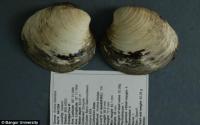 In February of last year, we posted about posidonia oceanica, known as Neptune grass, a variety of sea grass that covers the ocean floor from Spain to Cyprus. Some plants hare believed to be around 200,000 years old, making them the oldest living life form on the planet. The plant reproduces by cloning so the DNA of any given plant be very, very old. But what is the oldest non-colonial animal? Scientists gathered a mollusk from the Icelandic shelf in 2006 as part of a study of climate change. Mollusks are generally thought to live for around 100 years. One of the mollusks collected was much older.
In February of last year, we posted about posidonia oceanica, known as Neptune grass, a variety of sea grass that covers the ocean floor from Spain to Cyprus. Some plants hare believed to be around 200,000 years old, making them the oldest living life form on the planet. The plant reproduces by cloning so the DNA of any given plant be very, very old. But what is the oldest non-colonial animal? Scientists gathered a mollusk from the Icelandic shelf in 2006 as part of a study of climate change. Mollusks are generally thought to live for around 100 years. One of the mollusks collected was much older.
An arctica islandica bivalve mollusk, also known as an ocean quahogs, was found that was initially thought to be over 400 years old. It was nicknamed Ming the Mollusk, as it apparently lived during the Chinese dynasty, though with in a different neighborhood. More recent analysis, however, suggests that the mollusk was in fact more than 100 years older — dating back 507 years.
 Google has now extended its “Street View” imagery to well beyond where the streets and even the dry land ends. Its new “Street View – Oceans” lets you virtually dive on the coral reefs of the Bahamas, explore the wreck of the Civil War steamer Mary Celeste, swim with Galapagos sea lions, or chase sea turtles off Heron Island on the Great Barrier Reef, all without squeezing into a wet suit or even getting wet. Check it out – but be warned it is easy to get lost in the underwater panoramas.
Google has now extended its “Street View” imagery to well beyond where the streets and even the dry land ends. Its new “Street View – Oceans” lets you virtually dive on the coral reefs of the Bahamas, explore the wreck of the Civil War steamer Mary Celeste, swim with Galapagos sea lions, or chase sea turtles off Heron Island on the Great Barrier Reef, all without squeezing into a wet suit or even getting wet. Check it out – but be warned it is easy to get lost in the underwater panoramas.
An underwater volcano has creating a new island around 620 miles south of Toyko, Japan. According to the Associated Press it is roughly 660 feet in diameter, off the coast of Nishinoshima, a small, uninhabited island in the Ogasawara chain, which is also known as the Bonin Islands. Whether the island will survive erosion by the sea remains to be seen. Thanks to Phil Leon for contributing to the post.
According to the latest news on their website, the City of Adelaide, the oldest surviving composite clipper ship built in 1864, will be hoisted onto the deck of the heavy-lift ship MV Palanpur in the port of Rotterdam today. The heavy-lift ship will carry the historic clipper home to her name-sake city in Australia with several intermediate stops along the way. But, how does one lift 500 tonnes of historic ship and cradle onto the deck of a heavy-lift ship? The obvious answer is — carefully. For a more detailed answer watch the simulation below.
Clipper Ship ‘City of Adelaide’ Lifting Simulation onboard ‘MV Palanpur’
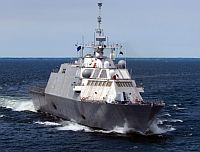 In March of this year, we posted about the repeated blackouts suffered on the USS Freedom as it made its way to a deployment in Singapore. Recently the ship was delayed due to failures in its water jet controls. In October it was sidelined by failures in the hydraulic systems. In July, the ship had generator and coolant system problems. In addition to the problems with the mechanical and control systems, the ship has suffered repeated hull cracking, which have limited speeds.
In March of this year, we posted about the repeated blackouts suffered on the USS Freedom as it made its way to a deployment in Singapore. Recently the ship was delayed due to failures in its water jet controls. In October it was sidelined by failures in the hydraulic systems. In July, the ship had generator and coolant system problems. In addition to the problems with the mechanical and control systems, the ship has suffered repeated hull cracking, which have limited speeds.
USS Freedom is the first of one of two designs of the U.S. Navy’s Littoral Combat Ships. A recent GAO report has also questioned whether the LCS ships’ communications systems are adequate for the networked missions intended. A report from earlier this year suggested that the LCS may nor be survivable in combat.
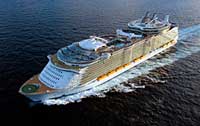 Royal Caribbean’s Allure of the Seas — the largest cruise ship in the world, is being taken out of service in February due a failure in one of its Azipod propulsion pods. Here we go again.
Royal Caribbean’s Allure of the Seas — the largest cruise ship in the world, is being taken out of service in February due a failure in one of its Azipod propulsion pods. Here we go again.
Royal Caribbean announces Allure of the Seas will undergo repairs in February 2014
Propulsion pods may be the greatest thing that ever happened to cruise ships. Or maybe the worst, when they don’t work, which is far too often. A propulsion pod is an electric motor which drives a propeller mounted on a rotating “pod” which extends out from the bottom of the ship. Because they can be made to rotate 360 degrees, the pod replaces the traditional rudder and stern thrusters and does away with the need for long propeller shaft runs. They are more fuel efficient than conventionally mounted propellers, by around 6-9%, which given today’s fuel costs is significant. Two manufacturers dominate pod propulsion — Rolls Royce who manufactures the “Mermaid pod” and ABB which manufactures the “Azipod.”
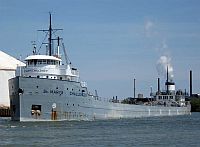
Photo: Lou Gerard
This is the last season for the Great Lakes self-unloading bulk carrier St. Mary’s Challenger (ex William P. Snyder, Elton Hoyt II, Alex D. Chisolm, Medusa Challenger, Southdown Challenger.) The ship has been in service for 107 years! She was re-engined 47 years ago and apparently her machinery is getting tired. She is not bound for the scrap yard, however. After considering installing a new engine room, her owners are converting her to a barge. Her stern will be cut off and her forward superstructure will be removed, but she will still be earning keep.
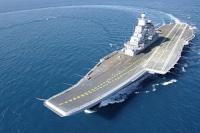 The Indian Navy has finally taken delivery of a modified the Kiev class aircraft carrier, which it purchased from the Russians in 2002. The ship was actually given to the Indian Navy with the stipulation that the estimated $800 million in modifications and repairs would be done in a Russian shipyard. Now, 11 years later and after spending approximately $2.3 billion dollars, the Indian Navy has finally commissioned the carrier, INS Vikramaditya.
The Indian Navy has finally taken delivery of a modified the Kiev class aircraft carrier, which it purchased from the Russians in 2002. The ship was actually given to the Indian Navy with the stipulation that the estimated $800 million in modifications and repairs would be done in a Russian shipyard. Now, 11 years later and after spending approximately $2.3 billion dollars, the Indian Navy has finally commissioned the carrier, INS Vikramaditya.
The Russians built a total of four Kiev class aircraft carriers. One was scrapped. Two were turned into Chinese military theme parks exhibits and/or hotels. It is still unclear whether the Chinese or the Indians got the better deal.
There is something truly magical about Bristol Pilot Cutters. A video by Stephen Morris about the pilot boats of Bristol.
 This is not supposed to happen. Two sailors on the Ticonderoga-class guided-missile cruiser USS Chancellorsville were injured when the ship was struck by its own drone, during training exercises off Southern California on Saturday. The sailors were treated for minor burns. There was also some damage reported to the ship which returned to San Diego for assessment.
This is not supposed to happen. Two sailors on the Ticonderoga-class guided-missile cruiser USS Chancellorsville were injured when the ship was struck by its own drone, during training exercises off Southern California on Saturday. The sailors were treated for minor burns. There was also some damage reported to the ship which returned to San Diego for assessment.
Malfunctioning Drone Hits Navy Ship While Training
USS Chancellorsville is named after a US Army defeat in the Battle of Chancellorsville, Virginia during the American Civil War. Thanks to Phil Leon for passing the news along.
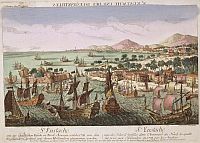
St. Eustatius 1781
On this day in 1776, Governor Johannes de Graaff of St. Eustatius returned the salute fired by the American brig Andrew Doria, which is considered to be the first international acknowledgment of the independence of the new republic of the United States. There is some disagreement over whether this was the “first salute.” An American schooner flying the Grand Union flag received a salute a month earlier in St. Croix. Nevertheless, St. Eustatius, or Statia, as it is commonly known, usually is given the credit by historians. Pulitzer Prize–winning historian Barbara Tuchman wrote, The First Salute: A View of the American Revolution in 1988.
Whether the salute was indeed intended as recognition of the young republic is open to question. The Andrew Doria fired an eleven gun salute on her arrival at Statia and received a nine gun salute in return. Technically, the Andrew Doria was a warship and should have received an eleven gun salute. A nine gun salute was appropriate for a merchant vessel. Governor de Graaff would later say that he was unaware of the newly adopted American colors and had ordered the Andrea Doria‘s salute returned out of normal courtesy.
If Statia received the credit for the first salute, it also suffered the consequences. Continue reading
The size of the typhoon Haiyan was staggering, and so too is the aftermath. Eleven million people were impacted by the storm, more than 600,000 were made homeless, and the death toll continues to rise. The BBC takes a look at why, a week after the storm hit, that getting help to those who need it, has been so difficult.
BBC News – What is making the Philippines relief effort so difficult?
Most of the media is referring to the massive slab of ice that has broken off the Western Antarctic Pine Island glacier as an “iceberg.” At 277 square miles of solid ice, I think an ice island is a more accurate designation. British scientists from Sheffield and Southampton universities have been awarded a £50,000 grant for a six-month study to track the iceberg as it drifts northward. They will track it and try to predict its path using satellite data. There is real concern that the the ice island could be hazardous to shipping in the Southern Ocean.
Huge iceberg adrift in Southern Ocean after calving from Pine Island Glacier
 I recently came across a video of the Viking longship replica Saga Oseberg tacking across the wind. Before seeing the video I would have thought that the only way to tack a longship, to bring the wind from one side of the bow to the other, would be to drop the sail and pull out the oars. Obviously, I was wrong. The long slender ship, with a single square sail and off-center rudder, can indeed tack. What is even more remarkable is that she is sailing at all.
I recently came across a video of the Viking longship replica Saga Oseberg tacking across the wind. Before seeing the video I would have thought that the only way to tack a longship, to bring the wind from one side of the bow to the other, would be to drop the sail and pull out the oars. Obviously, I was wrong. The long slender ship, with a single square sail and off-center rudder, can indeed tack. What is even more remarkable is that she is sailing at all.
The original Oseberg ship is a well preserved Viking longship which was found in a burial mound on the Oseberg farm near Tønsberg, Norway in 1903. The reconstructed ship, believed to date from just after the year 800, is now in the Viking Ship Museum in Oslo. The Oseberg ship is different from other Viking ships excavated from burial mounds in that it has lower freeboard and less displacement. Some suggested that it was built not as a sailing ship but as simply a burial ship. This view was reinforced when a replica of the ship sank on its maiden voyage in 1988. The ship was refloated, only to sink again in 1992.
Nevertheless, some researchers believed that the original reconstruction of the ship was in error. Continue reading
There are indeed creatures in the oceans which could be called “sea monsters.” At the end of last month we posted about two very real “sea serpents” – oar fish that washed up on the coast of Southern California. Here is an account of another very real, if rarely seen, “sea monster,” the scyphomedusa Deepstaria. Recently a video from April 2012 has washed up onto the surface of cyberspace with the headline, “Massive Unidentified Sea Monster caught on Oil-Rig Cam.”
It is a fascinating video showing an undulating creature that almost looks like free-flowing fabric. The video itself is approaching two years old, so in internet time, it is is not particularity new, even if recent posts have given it a second life. The video was taken by an ROV inspecting a drill rig off Britain. The creature on the video is also not “unidentified.” It is apparently a jellyfish, a scyphomedusa Deepstaria, Whether or not it is a “sea monster” is up to the viewer to decide.
Massive Unidentified Sea Monster Caught on Video Off Oil-Rig
 Great news. The captain and chief engineer of the 222′ supply boat C-Retriever, who were kidnapped off the coast of Nigeria on October 23th, have been released following the payment of ransom. The two Americans are reported to be in good health and en-route to the United States. The supply boat is owned Edison Chouest Offshore, based in Louisiana.
Great news. The captain and chief engineer of the 222′ supply boat C-Retriever, who were kidnapped off the coast of Nigeria on October 23th, have been released following the payment of ransom. The two Americans are reported to be in good health and en-route to the United States. The supply boat is owned Edison Chouest Offshore, based in Louisiana.
Two American sailors freed after being taken hostage off Nigeria coast
 The USS George Washington battle group has been ordered to depart from Hong Kong, where it had been making a port call, and to steam for the Philippines to support relief efforts in the aftermath of Super Typhoon Haiyan which stuck the archipelago last Friday. The battle group consists of the aircraft carrier, USS George Washington, the cruisers USS Antietam and USS Cowpens, and the destroyer USS Mustin. The supply ship USNS Charles Drew and the destroyer USS Lassen are also under-weigh and will rendezvous with the battle group on-route. The ships should arrive in the Philippines in between 48 and 72 hours.
The USS George Washington battle group has been ordered to depart from Hong Kong, where it had been making a port call, and to steam for the Philippines to support relief efforts in the aftermath of Super Typhoon Haiyan which stuck the archipelago last Friday. The battle group consists of the aircraft carrier, USS George Washington, the cruisers USS Antietam and USS Cowpens, and the destroyer USS Mustin. The supply ship USNS Charles Drew and the destroyer USS Lassen are also under-weigh and will rendezvous with the battle group on-route. The ships should arrive in the Philippines in between 48 and 72 hours.
USS George Washington is a Nimitz class nuclear-powered supercarrier, which carries 5,000 Sailors and more than 80 aircraft. Embarked on board USS George Washington, is Carrier Air Wing Five, which includes MH-60 Seahawk multimission naval helicopters, capable of performing disaster relief. On their arrival these ships and aircraft will be able to provide humanitarian assistance, supplies, and medical care in support of the Philippine relief effort.
The Royal Navy has also dispatched the destroyer HMS Daring from Singapore to assist in relief efforts.
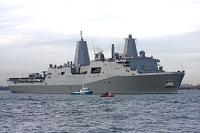 The USS New York called in New York harbor over the weekend to help celebrate Veteran’s Week. The ship is the fifth of the San Antonio class of amphibious transport dock ships. The ship’s bow includes 7.5 tonnes of salvaged steel from the World Trade Center, which was attacked on 9/11/2001. The best news about the ship is that it appears that the she and her sister vessels may have, at long last, become fully operational.
The USS New York called in New York harbor over the weekend to help celebrate Veteran’s Week. The ship is the fifth of the San Antonio class of amphibious transport dock ships. The ship’s bow includes 7.5 tonnes of salvaged steel from the World Trade Center, which was attacked on 9/11/2001. The best news about the ship is that it appears that the she and her sister vessels may have, at long last, become fully operational.
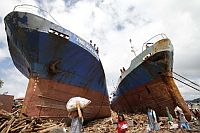
Typhoon Haiyan survivors on Sunday pass by two vessels that were washed ashore during the storm in Tacloban, a city in Leyte, a province in the central Philippines.
In the aftermath of Super Typhoon Haiyan, the Philippines is beginning to attempt to cope with what has been described as the worst natural disaster in its history. The typhoon hit the archipelago with winds approaching 200 mph and drove a storm surge which leveled cities and villages. More than 10,000 are fear to have been killed. Damaged and obstructed roads have hampered the distribution of aid to hundreds of thousands who lack food, water and shelter.

